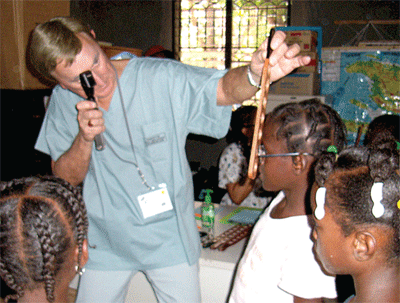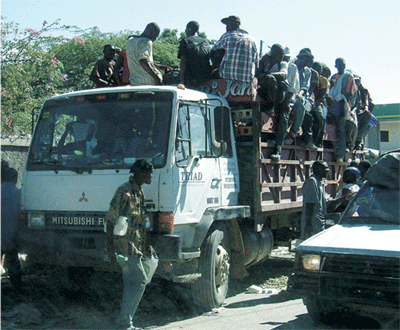“We did our first clinic day on Sunday, then the same on Monday and Tuesday,” says Dr. Pifer. “We had actually finished for the day, and we were touring the gardens in the compound—they grow food to feed the children of the area. All of a sudden, all of us started feeling lightheaded—like we were spinning in a chair. We looked down, and the ground was moving. There was a gate by me, and I saw it start to fling back and forth. That’s when we figured out what was going on.”
So far out from the epicenter of the quake, the compound didn’t experience any of the structural damage that affected Port-au-Prince. In fact, the members of the VOSH team didn’t think anything of it. After dinner that night, however, Fr. Meaux told the team the news: It was much, much worse in Port-au-Prince. He also suggested that the team contact their families and friends back home to let them know they were all right.
Barbara Plaugher, a registered nurse, had scheduled the team to visit the facilities in Port-au-Prince before the disaster struck.
“There were no communications with Port-au-Prince. We couldn’t get there. We didn’t know if they were safe or not,” she says.
The team decided to stay at the mission and finish out their three remaining days of clinic. “We saw everyone we planned to see,” says Dr. Pifer.

Optometrist Ed Winbigler of VOSH Ohio examines a young Haitian girl’s eyes in the days before the quake hit.
Photo: Barbara Plaugher, R.N., VOSH Ohio
But then, he adds, the challenge was how to get home.
“We had access to a computer and e-mail,” says Ms. Plaugher. “People were telling us to go north and get a missionary flight service to take us out. But we were unable to do so.”
News came on Friday from the embassy that an evacuation was ordered. The private planes the group had chartered from Port-au-Prince to the mission were unable to fly them back, and border crossings into the Dominican Republic were not permitted, so the decision was made to travel back to Port-au-Prince.
The team was able to hire a van, tie some luggage to the top (they left much of their supplies behind to travel lighter), and make the trek to the city.
“The roads were terrible,” says Ms. Plaugher. But, they were passable, and hours later, the team arrived at the airport.
Because the airport is to the north of Port-au-Prince, the team avoided the worst of the earthquake’s effects. “We saw destruction, collapsed buildings, and I’m thankful to God that we didn’t have to go through the center of the city,” Dr. Pifer says. “The streets were just filled with people trying to get out of Port-au-Prince, and we were trying to get into it.”
The team only knew one thing: They were getting back to the U.S. somehow. “The embassy ‘advised’ us to get to the airport. When we got there, the terminal was compromised, so we waited on the tarmac,” Dr. Pifer says.
“The airport was surrounded and secured by members of the 82nd Airborne Division of the U.S. Army,” recalls Ms. Plaugher. “The soldiers led us out, 25 at a time, to the tarmac.”
There, the soldiers encircled the evacuees and waited with them until a plane landed. “We were able to board a U.S. Air Force cargo plane,” says Ms. Plaugher. “We didn’t know where we were going until we were on the plane, and it turned out to be McGuire Air Force base in New Jersey.”
Once there, the team was given access to phones to make arrangements for flights home. They were given a police escort to the airport so that they could arrive home on the same day they had originally scheduled—Saturday, January 16—but under very different circumstances.

As the VOSH Ohio team made its way to the airport, they passed countless Haitians fleeing Port-au-Prince.
Photo: Barbara Plaugher, R.N., VOSH Ohio
“What will leave the strongest impression in my mind is the prayer and support expressed from people here—the phone calls to my home, the people who prayed for our safe return,” says Dr. Pifer. “I think it was more frightening for our friends, family and loved ones [than for us] because they saw what was on the news. The well wishes and support were amazing, and that’s what affected me the most.”
Once the team returned home, Ms. Plaugher adds, they found out that the children and workers of the orphanage and children’s hospital they had planned to visit in Port-au-Prince were safe.
What You Can Do
Optometry’s Charity—The AOA Foundation is providing information to AOA members regarding international aid for Haiti. Optometry Giving Sight is working with VOSH, the International Centre for Eyecare Education and the Caribbean Optometrists Association to identify and fund projects for emergency relief and to assist in the reconstruction process through the establishment of sustainable vision care. Donations are being accepted at
http://vm.givingsight.org/how_we_help/project_reports/haiti.asp.
Go to www.optometryscharity.org/haiti for more information.

